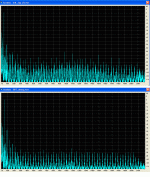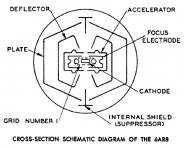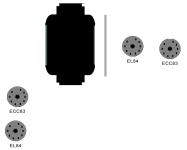I've been sort of puzzled by anecdotal reports of the effects of demagnetization on tubes. The hypothesis is that residual magnetism might cause the electron paths to be deflected, changing gain, transconductance, and distortion.
Now, to be clear, there's no actual evidence of the audibility of demagnetization, just anecdotes. But hey, that's where we start. From a physics point of view, this is puzzling since the effects of magnetic fields are small (relative to electric fields) and the electron stream in most tubes has an extraodinarily high velocity- relativistic, in fact. Unlike a CRT, the electron path is VERY short inside a tube, so there's not much time to deflect- the curvature has to be quite strong to be significant. Physics models aside, I'm curious as to whether any measurable change could occur via demagnetization.
As usual, I was limited to what I have on hand and that does not include a demagnetizer. So I went about this the opposite way- I set up a tube in a jig, measured gain and distortion in a "raw" tube, then repeated the measurements in the presence of a magnetic field.
Since I'm elbow deep in ECC88 measurements, I used that as a guinea pig. The test setup was what I showed in the "Getting Jiggy" thread: a cascode-CCS-loaded voltage amp with LED biasing. The current was set to 8.0mA, cathode bias at 1.7V, 40V p-p output, 140V B+. The tube was a Siemens ECC88, date code 887. Measurement repeatability throughout these tests has been about +/-0.5 dB.
Initial measurements:
Gain = 21.5 (all the Siemens ECC88s I tested had this low out-of-spec gain)
2nd HD = -41.7dB
3rd HD = -73.1dB
4th HD = -73.7dB
The initial measurements were repeated before and after each of the following measurements to check for drift and error. All control measurements fell within +/-0.5dB of the initial measurement.
First magnetic field measurement:
A refrigerator magnet (from a Teletubbies set, Tink Winky, purple) was placed on the side of the tube and gain/distortion were remeasured.
Gain: 21.5
2nd HD = -41.6dB
3rd HD = -72.8dB
4th HD = -74.1dB
The magnet was placed on the top of the tube to see if there is any geometric effect:
Gain: 21.5
2nd HD = -41.8dB
3rd HD = -73.0dB
4th HD = -74.2dB
Hmm, nothing significant. Could it be a function of strength? I repeated the measurement, but substituted a magnet taken from a blown Dynaudio D-28; this magnet has a FIERCE pull and readily attracts every nut and bolt within several centimeters. As before, the magnet was placed directly touching thre tube envelope. Results:
Gain: 21.5
2nd HD = -41.8dB
3rd HD = -72.6 dB
4th HD = -74.8dB
As before, no significant difference.
My test was clearly limited to one type of tube, so I make no claim of universality. BUT... lacking either repeatable data showing an effect or controlled listening tests indicating audibility, I would be very skeptical of claims of sonic improvement through demagnetization.
Now, to be clear, there's no actual evidence of the audibility of demagnetization, just anecdotes. But hey, that's where we start. From a physics point of view, this is puzzling since the effects of magnetic fields are small (relative to electric fields) and the electron stream in most tubes has an extraodinarily high velocity- relativistic, in fact. Unlike a CRT, the electron path is VERY short inside a tube, so there's not much time to deflect- the curvature has to be quite strong to be significant. Physics models aside, I'm curious as to whether any measurable change could occur via demagnetization.
As usual, I was limited to what I have on hand and that does not include a demagnetizer. So I went about this the opposite way- I set up a tube in a jig, measured gain and distortion in a "raw" tube, then repeated the measurements in the presence of a magnetic field.
Since I'm elbow deep in ECC88 measurements, I used that as a guinea pig. The test setup was what I showed in the "Getting Jiggy" thread: a cascode-CCS-loaded voltage amp with LED biasing. The current was set to 8.0mA, cathode bias at 1.7V, 40V p-p output, 140V B+. The tube was a Siemens ECC88, date code 887. Measurement repeatability throughout these tests has been about +/-0.5 dB.
Initial measurements:
Gain = 21.5 (all the Siemens ECC88s I tested had this low out-of-spec gain)
2nd HD = -41.7dB
3rd HD = -73.1dB
4th HD = -73.7dB
The initial measurements were repeated before and after each of the following measurements to check for drift and error. All control measurements fell within +/-0.5dB of the initial measurement.
First magnetic field measurement:
A refrigerator magnet (from a Teletubbies set, Tink Winky, purple) was placed on the side of the tube and gain/distortion were remeasured.
Gain: 21.5
2nd HD = -41.6dB
3rd HD = -72.8dB
4th HD = -74.1dB
The magnet was placed on the top of the tube to see if there is any geometric effect:
Gain: 21.5
2nd HD = -41.8dB
3rd HD = -73.0dB
4th HD = -74.2dB
Hmm, nothing significant. Could it be a function of strength? I repeated the measurement, but substituted a magnet taken from a blown Dynaudio D-28; this magnet has a FIERCE pull and readily attracts every nut and bolt within several centimeters. As before, the magnet was placed directly touching thre tube envelope. Results:
Gain: 21.5
2nd HD = -41.8dB
3rd HD = -72.6 dB
4th HD = -74.8dB
As before, no significant difference.
My test was clearly limited to one type of tube, so I make no claim of universality. BUT... lacking either repeatable data showing an effect or controlled listening tests indicating audibility, I would be very skeptical of claims of sonic improvement through demagnetization.
No, I don't think the grid wires are magnetic... Would be pretty nasty if they were attracted by the magnet to touch the cathode 
I was thinking the magnetic field might deflect electrons around the control grid wires to collide with the screen grid. Normally the screen grid sits in the 'shadow' of the control grid, so screen current is low. The magnetic field might change that, increasing screen current, causing distortion, or something else interesting. Of course I have no idea if this can happen in real life...

I was thinking the magnetic field might deflect electrons around the control grid wires to collide with the screen grid. Normally the screen grid sits in the 'shadow' of the control grid, so screen current is low. The magnetic field might change that, increasing screen current, causing distortion, or something else interesting. Of course I have no idea if this can happen in real life...
I have no experience with demagnetising tubes and really no opinion on the effect but would be very surprised if thd measurements showed anything.
If there is a single parameter not worth measuring for audio purposes my choice will be thd. It probably has some audibility once exceeding the 1% range but musically it's really benign.
It is however great for 'myth debunking' as this hopeful post proves:
If there is a single parameter not worth measuring for audio purposes my choice will be thd. It probably has some audibility once exceeding the 1% range but musically it's really benign.
It is however great for 'myth debunking' as this hopeful post proves:
Now we need someone with access to Liquid Nitrogen to put the test to the "Cryo tube" craze. -another gimmick that I'm highly skeptical of.
John Swenson used a spectrum analyser to determine the measurable difference before and after degaussing. His test was on Beam Deflection Tubes so we probably can't extrapolate it to "normal" or other tubes. But I found it an interesting experiment nevertheless.Now, to be clear, there's no actual evidence of the audibility of demagnetization, just anecdotes. But hey, that's where we start.
http://db.audioasylum.com/cgi/m.mpl?forum=tubediy&n=57559&highlight=demagnetization&r=&session=
Attachments
The 6AR8 is most certainly not the 'average' valve....
Have a look at the cross section diagram attached (From the GEC Datasheet)
It looks like the measurement is the spectrum resulting from a ~500Hz input (the 0dB reference). So it seems that it resulted in increased second and third harmonic, while decreasing higher orders and noise.
Have a look at the cross section diagram attached (From the GEC Datasheet)
It looks like the measurement is the spectrum resulting from a ~500Hz input (the 0dB reference). So it seems that it resulted in increased second and third harmonic, while decreasing higher orders and noise.
Attachments
That's what I said...too...The 6AR8 is most certainly not the 'average' valve....
Nevertheless...we don't even know what to measure in audio circuits...there is virtually no correlation between measured distortion and perceived sound quality. So even if SY had found a measured difference, that does not mean that it would automatically lead to a change in perceived sound quality.
In short ...you can't prove or disprove ( to everyone) that degaussing leads to better or worse sound. So we are back to square one AFAIAC, that is do it if you like or don't if you don't..
But I commend SY for trying.
Gday.
A bit OT.
But it do have a similarety.
Attached is a image of a modefied Tanberg circuit,
there is a shield between the mainsT, and right 84/83.
Under the moding prosses, i forgot to attach the shield,
resulting in that the right 84 did start to sound "crispy"
and got a grey color top.
The ECC83 behind it, didn`t get hurt at all.
(The chassis was made like this, if i was to make a new one,
it probably wouldn`t look like this.)
The tubes on the left, is untouched by the magnetic, from the
trafo.
Another thing i tried, when i was at it.
On the work bench, i did try to adjust the space,
between the tubes, and there was a diff. (maybe placibo.??)
Anyway, this bring up this question to me.:
Is it also to belive, there is a benefit of shielding the tubes.??
not just the tubes from any dc source, but also from each other.?

A bit OT.
But it do have a similarety.
Attached is a image of a modefied Tanberg circuit,
there is a shield between the mainsT, and right 84/83.
Under the moding prosses, i forgot to attach the shield,
resulting in that the right 84 did start to sound "crispy"
and got a grey color top.
The ECC83 behind it, didn`t get hurt at all.
(The chassis was made like this, if i was to make a new one,
it probably wouldn`t look like this.)
The tubes on the left, is untouched by the magnetic, from the
trafo.
Another thing i tried, when i was at it.
On the work bench, i did try to adjust the space,
between the tubes, and there was a diff. (maybe placibo.??)
Anyway, this bring up this question to me.:
Is it also to belive, there is a benefit of shielding the tubes.??
not just the tubes from any dc source, but also from each other.?
Attachments
Geir, I doubt that the leakage magnetic flux from the mains transformer would cause the top (the getter?) of the EL84 to take on a grey colour. If the getter has taken on a whitish colour, it has oxidised in a vain attempt to preseve the vacuum inside the valve.
Is the shield made from something magnetic, or is it some other metal (like aluminium). If it's not something like iron, it is only an electrostatic screen because magnetic flux treats aluminium basically the same as air.
Is the shield made from something magnetic, or is it some other metal (like aluminium). If it's not something like iron, it is only an electrostatic screen because magnetic flux treats aluminium basically the same as air.
Grid wires are not magnetic, but support structures can be. So are many of the lead-out wires. One excellent text I have on tubes suggests that stray magnetism in these bits could potentially cause distortion. But I don't see that, nor do I see anything like the noise reduction in John Swenson's post. I note that my measurements have about a 30 dB better resolution than his.
A spectral analysis is indeed more revealing than a simple THD measurement, which is why I chose that method. If stray magnetism were an issue, surely one would see its effect in distortion, distribution of harmonics, or gain. I'm not ready to abandon basic physics.
I probably will try this again with one or two other types of tubes- I don't claim that these measurements are universal- but I can't see that there can be much effect from stray magnetic fields (orders of magnitude weaker than what I applied) when the electron velocity is high and the path is short. If I can dig up a 6AR8, I'll rerun Swenson's measurements; I'm suspicious that he's not measuring what he thinks he's measuring.
A spectral analysis is indeed more revealing than a simple THD measurement, which is why I chose that method. If stray magnetism were an issue, surely one would see its effect in distortion, distribution of harmonics, or gain. I'm not ready to abandon basic physics.
I probably will try this again with one or two other types of tubes- I don't claim that these measurements are universal- but I can't see that there can be much effect from stray magnetic fields (orders of magnitude weaker than what I applied) when the electron velocity is high and the path is short. If I can dig up a 6AR8, I'll rerun Swenson's measurements; I'm suspicious that he's not measuring what he thinks he's measuring.
LN2
So do I. I'm still not sure how "cryo" corresponds with Arrhenius rate laws...
If someone wants to tell me (or Kevin) the timings involved, I'll do some before and after measurements. I'm somewhat unimpressed with the data presented by the companies that sell these services.
So do I. I'm still not sure how "cryo" corresponds with Arrhenius rate laws...
If someone wants to tell me (or Kevin) the timings involved, I'll do some before and after measurements. I'm somewhat unimpressed with the data presented by the companies that sell these services.
Unfortunately, I don't have my Big Book of Conversion Factors with me here at the moment, but IIRC, it was on the order of magnitude of 0.1c. If no-one has piped up with the right numbers by the time I get home tonight, I'll look in my notebook and get you a better answer.
If you've got a copy of "Valve Amplifiers," Jones does the calculation, too.
EDIT: I see EC8010 has piped up in quite a timely way.
If you've got a copy of "Valve Amplifiers," Jones does the calculation, too.
EDIT: I see EC8010 has piped up in quite a timely way.
- Status
- This old topic is closed. If you want to reopen this topic, contact a moderator using the "Report Post" button.
- Home
- Amplifiers
- Tubes / Valves
- Tubes and magnetic fields


